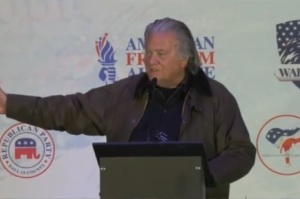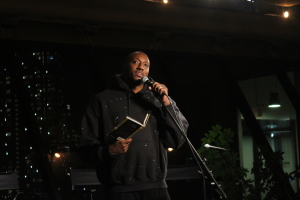NHCLC Speakers Urge Church Leaders to Address Human Trafficking Within Their Congregations During Justice Summit
WASHINGTON – Human sex trafficking is oftentimes viewed as a taboo topic within the church, however, Monday night during the National Hispanic Christian Leadership Conference (NHCLC) Justice Summit, the topic was openly discussed in front of Hispanic church leaders who were urged to recognize the issue and take action against it.
"There are more people in slavery today than ever before in the history of humanity," said the Rev. Samuel Rodriguez, president of the NHCLC. "Even in America, the numbers range from 100,000 to 500,000, so on average, there are 300,000 people, primarily children, sold every day and involved in sex trafficking."
In church, this topic along with the discussion of pornography is oftentimes not addressed because some of the "Johns" as Rodriguez put it, are members within the same congregations, however, NHCLC is leading the conversation through their sex trafficking initiative. At the helm of their efforts is Danielle Jones, who spoke during the event to facilitate a dialogue about the issue and whom Rodriguez deemed "anointed" to lead the movement.
According to Jones, the church does not have an established stance regarding the $32 billion dollar trafficking industry because they lack the education about the issues that pertain to human and sex slavery.
"The church needs to recognize that human trafficking is something that we need to address, we need to understand how to relate to this epidemic and the individuals involved and how to respond. The church hasn't grasped that yet," said Jones.
In order to take action, church leaders and others alike need to know facts beginning with the basics like the average age of entry into sex trafficking, which is 14, says Jones. According to statistics, there is a seven year life cycle from the time of entry into the sex slavery life to the time a victim is either no longer valuable, dead or has AIDS.
Currently, there are 27 million human slaves and 4.5 million sex slaves around the world and the most susceptible group prone to falling victims are young girls between the ages of 11 and 17. In the U.S. alone, the youngest victim ever rescued from trafficking has been 10, and the youngest sold into sex slavery, according to Jones, has been 6.
"In other countries, it happens much younger, we're talking about age 4. I know of kids who remember abuse back to age 3 and have given details," said Jones.
Vulnerability is the primary reason that girls become involved in sex trafficking to begin with. Victims usually come from abusive homes and placed within the foster care system where sometimes they suffer more abuse. As many as 98 percent of child victims in the U.S. come from foster care.
However, not all victims come from broken homes. Some have had a fairly good upbringing, or in rare cases they come from affluent families who become involved because their parents have been disengaged in their lives. Jones also says pimps are everywhere from schools to malls looking to recruit girls, making it easy for those who are vulnerable and seeking a way out.
"Victims have no idea what love looks like so they hit the streets. When they get into the life of trafficking, they don't run because when they've been tortured, beaten, abused and threatened, their mind is caged and they're going to go wherever that pimp tells them to go and they're going to come back every single time," said Jones.
On a worldwide scale, sex trafficking is a prevalent issue in almost every country, and oftentimes the reason for entering the sex slave life is because girls are born into poor families and they seek an alternative to their living conditions.
In Europe, girls are sometimes sold into sex slavery by their parents who are desperate for their daughters to rise from poverty. However, in some cases, those girls are then taken out of their countries and sold into other nations where they experience further abuse. Poverty is also the driving force for many girls in Africa who make a personal decision to become sex slaves for the economic benefit of their families before they are forcefully sold.
Under U.S. federal law, child prostitution is a form of human trafficking but many states do not offer legal protection for minor victims or services to care for severely victimized children. In many cases, these victims are treated as delinquents, which harm them even further.
"Minor victims are arrested as criminals and put into juvenile hall. There are safe harbor laws, but we need to work with law enforcement and congressional leaders because kids should never be arrested," said Jones. "They need a safe haven where they can go to and stay and that's where restoration homes are desperately needed. There aren't enough homes that work with these victims, there aren't enough people who volunteer or work in this field, there just isn't."
Although the church may know these facts, Rodriguez says sex trafficking cannot be addressed without first addressing pornography.
"Viewing pornography is an anesthetic to the moral conscious. It dumbs the soul, it takes away all sentiment, emotion, conviction, and viewing it prompts a man to view females, regardless of their age, as sex objects for pleasure and satisfaction. It is pornography and money that drives the sex trafficking industry, we have to address both," said Rodriguez.
Jones said that oftentimes porn viewers cannot differentiate whether the person on film is forced into trafficking or if they are an adult entertainment star. Viewers are also able to see live, on demand porn which at some point is bound to include a human trafficking victim, which makes the link between porn and trafficking clearly evident.
"When kids or women are in the midst of trafficking oftentimes they are being filmed, and that becomes pornography and oftentimes that [video] is given to the person who purchased the service as a 'souvenir' and it's put online," said Jones.
She continued, "As pornography goes on and as the demand and addiction becomes more intense, there's a direct link between the intensity and need for more and more perverse pornography, which leads to younger and younger victims; and truly, anyone under 18 isn't signing up to say, 'I want to be sold for sex,' so it's a trafficking situation."
Pornography itself is a major issue within churches as 47 percent of Christian couples cite porn as a martial issue, according to Jones. She also says young men oftentimes begin their addiction during their preteen years which is the reason she urges men within the church to stand up as mentors for those whose porn infatuation is just beginning.
"Men need to stand up as fathers because there are so many children who don't have dads. Those in the church need to mentor other young men in how to become fathers and mentor them into what their future can look like," said Jones. "They also need to stand up in holiness and righteousness and mobilize out into the communities, juvenile halls, and do life with other young boys and show them that their future doesn't have to look like what their upbringing or past may be."
She also pressed leaders at the NHCLC Justice Summit to engage in prayer in addition to education about sex trafficking and asked for their commitment as the organization's initiative is set to take on projects that will directly address all relative issues pertaining to human trafficking.



























